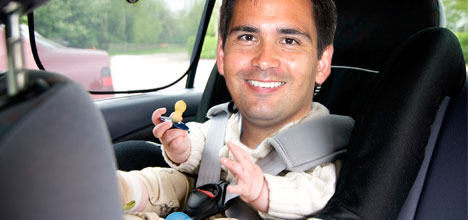Children up to the age of seven-years-old will be required to sit in a car seats under new rules announced today.
The proposed changes to the Ministry of Transport Action Plan for Safer Journeys will raise the mandatory age of restraint requirements from the current five-years-old to seven-years-old, and eight-years-old if a seat is available.
Associate Minister of Transport Simon Bridges says raising the age of children required to travel in car restraints from five to seven-years-old is a 'sensible and safe” move. Photo: Digitally altered.
Tauranga MP and Associate Minister of Transport Simon Bridges says the changes are a sensible and safe move to help keep New Zealand children safe.
'Following consultation and public education about the changes we can expect this to be fully enforced in about one year.”
The proposed changes, potentially implemented by next October, will mean a two year increase on the current mandatory age for child restraints.
Simon says both international and local research shows in an event of a crash, young school age passengers are at considerable risk if they are only restrained by an adult seatbelt.
'If you look around the OECD - the developed world - we have the most child injuries and the lowest child restraint age.
'The reason all the other countries are higher is because the research makes very clear that young school children are at considerable risk if they are only wearing an adult seatbelt.”
Simon says injury risk can be significantly reduced by having child passenger use age appropriate restraints, such as booster seats.
'There are different age appropriate restraints but for school children it is a booster seat. It lifts the children up and puts the seatbelts where they belong so that the child has a greatly reduced risk of really serious abdominal, spine, neck and head injuries that in extreme cases can result in death.”
Simon says the changes will need to be flexible enough to accommodate larger families and emergency trips.
'We are going to take some more time and go through a public consultation before we implement this change to ensure that practical issues like issues to deal with large families and emergency trips are dealt with practically.”
'I have talked with Plunket, hospital staff, mums and dads and many of the say to me this is not before time, it's the right time to do it.”
An education campaign and an appropriate lead-in period before changes come into effect will assist with the transition.
The Motor Trade Association is welcoming the move with spokesperson Ana Zandi saying it is a postive step to reduce the number of young children in unnecessary danger.
'Research shows that an adult seatbelt is not enough to protect young children if they have been involved in a serious car crash. Adult seatbelts are designed for adult bodies not for young children who are safer in a child restraint or booster seat until they are 148cm tall.”
'We continue to have one of the highest child road fatality rates in the OECD. Research also shows that vehicles are the number one killer of our children, with around one in five child fatalities.”
In the 2010 calendar year 304 children aged five to nine years were either injured or killed in road crashes.
'There is no doubt that properly used child restraints and safety belts significantly reduce the risk of serious injuries and fatalities in a vehicle crash. This new rule will certainly go a long way towards helping to bring these numbers down and keep our children safe on the roads,” says Zandi.
The change will bring New Zealand in line with Australian rules.



1 comment
Appropriate?
Posted on 04-10-2012 14:31 | By penguin
Simon looks quite at home in the picture - restrained!
Leave a Comment
You must be logged in to make a comment.